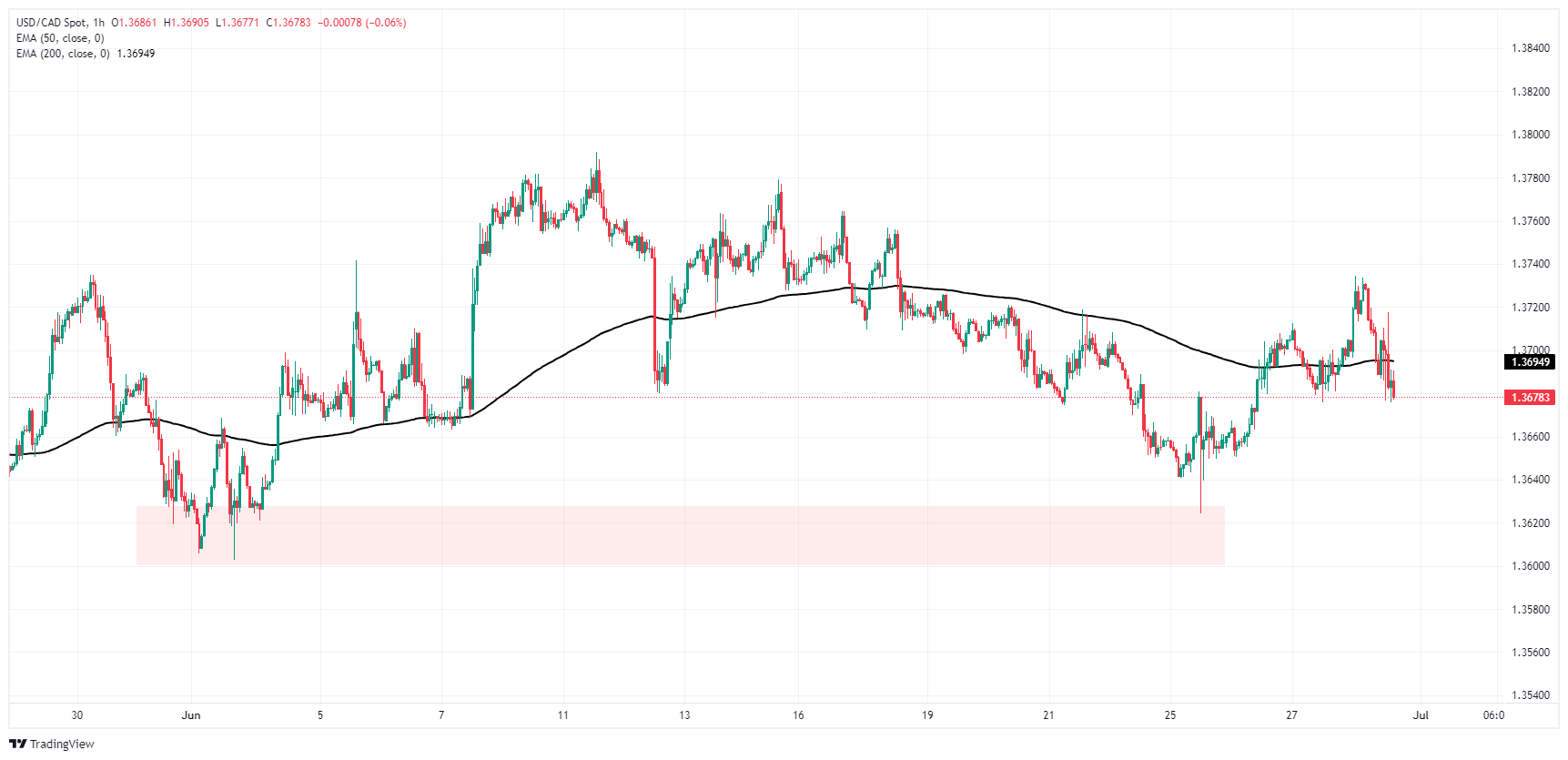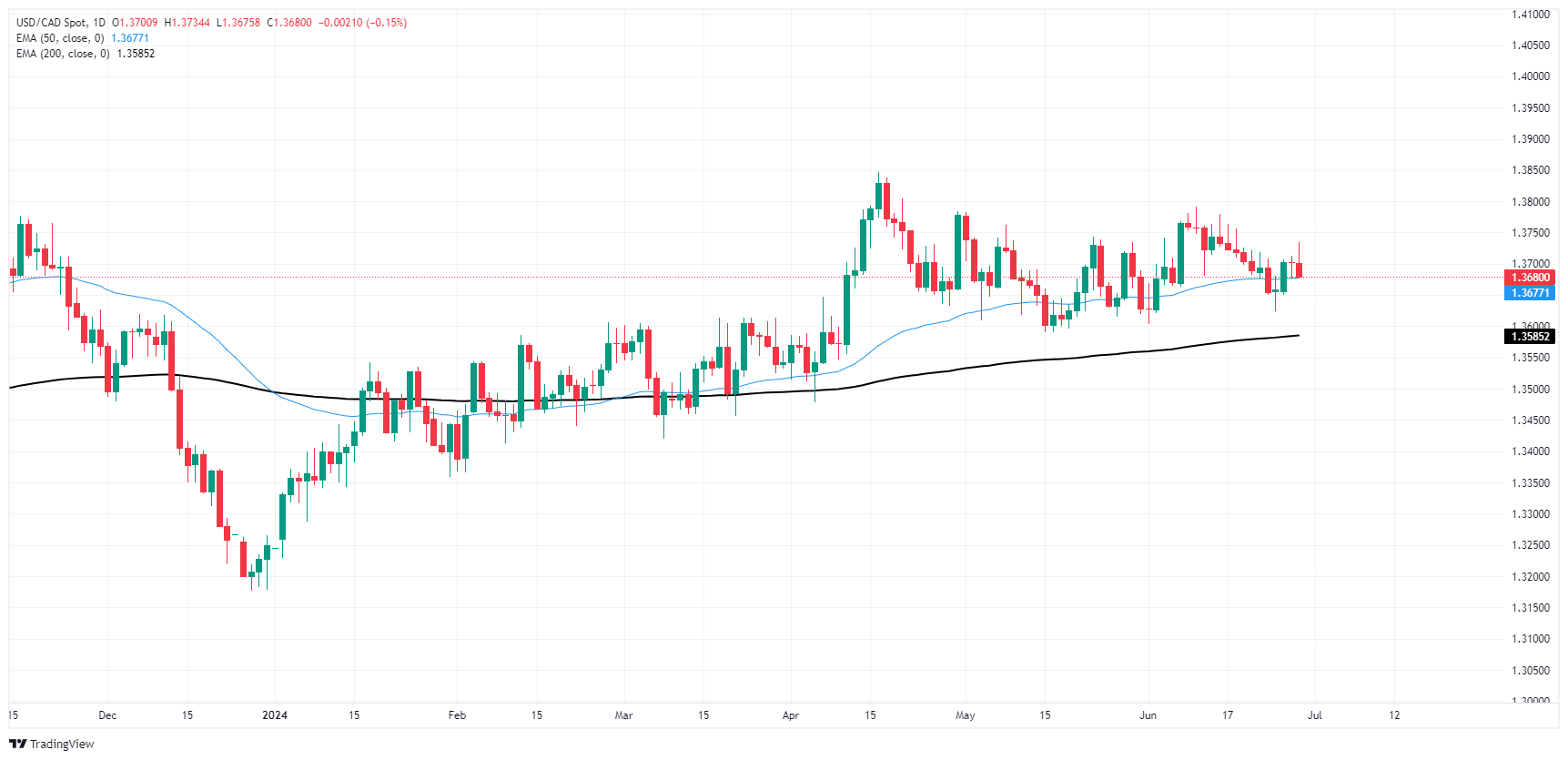- The Canadian Dollar is buoyed by rising market sentiment.
- Canada recorded a 0.3% increase in GDP, supporting the CAD.
- US PCE inflation also fell, raising hopes for a rate cut.
He Canadian Dollar (CAD) The U.S. dollar found some upside room on Friday, rising a tenth of a percentage point against the U.S. dollar amid volatile intraday price action after key economic data largely met market expectations. Canada’s Gross Domestic Product (GDP) rose and U.S. Personal Consumption Expenditure (PCE) Price Index inflation figures cooled slightly.
Canada posted a slight gain in GDP growth in April, rebounding from the flat figure the previous month. A U.S. data docket also broadly met market expectations, although U.S. personal spending missed expectations despite an improvement following revision.
Market Drivers Roundup: Canadian GDP rebounds, US inflation continues to ease for now
- Canada’s monthly GDP recorded an increase of 0.3% in April, meeting market expectations and recovering from 0.0% the previous month.
- US PCE Price Index inflation also slowed to 2.6% annually in May, meeting market forecasts and cooling from 2.8% previously.
- Market bets on a September rate cut by the Federal Reserve (Fed) have increased following the PCE. According to CME’s FedWatch tool, rate markets are pricing in a 66% chance of at least a quarter-point cut by the Fed on September 18, up from a flat 60% before the PCE inflation.
- The University of Michigan (UoM) 5-year consumer inflation expectations also dropped to 3.0% in June, from 3.1% previously.
- The UoM Consumer Sentiment Index for June also rose to 68.2 from 65.6, beating the market median forecast of 65.8.
Canadian Dollar PRICE Today
The table below shows the exchange rate of the Canadian Dollar (CAD) against major currencies today. The Canadian Dollar was the strongest currency against the Japanese Yen.
| USD | EUR | GBP | JPY | CAD | AUD | NZD | CHF | |
|---|---|---|---|---|---|---|---|---|
| USD | -0.15% | -0.02% | 0.03% | -0.14% | -0.41% | -0.20% | -0.01% | |
| EUR | 0.15% | 0.12% | 0.17% | 0.00% | -0.27% | -0.06% | 0.13% | |
| GBP | 0.02% | -0.12% | 0.02% | -0.13% | -0.39% | -0.18% | -0.02% | |
| JPY | -0.03% | -0.17% | -0.02% | -0.19% | -0.44% | -0.24% | -0.05% | |
| CAD | 0.14% | -0.01% | 0.13% | 0.19% | -0.28% | -0.06% | 0.10% | |
| AUD | 0.41% | 0.27% | 0.39% | 0.44% | 0.28% | 0.21% | 0.38% | |
| NZD | 0.20% | 0.06% | 0.18% | 0.24% | 0.06% | -0.21% | 0.16% | |
| CHF | 0.01% | -0.13% | 0.02% | 0.05% | -0.10% | -0.38% | -0.16% |
The heatmap shows percentage changes of major currencies. The base currency is selected from the left column, while the quote currency is selected from the top row. For example, if you choose the Canadian Dollar from the left column and move along the horizontal line to the US Dollar, the percentage change shown in the chart will represent the CAD (base)/USD (quote).
Technical Analysis: Canadian Dollar Regains Ground on Friday, Sending USD/CAD to Familiar Levels
The Canadian dollar found a bid on Friday, gaining ground against most of its major currency pairs as markets prepare to close out a relatively quiet week of trading. The CAD gained about a tenth of a percentage point against the US Dollar on Friday and rose almost a quarter of a percentage point against the widely beaten Japanese Yen.
USD/CAD briefly found a new weekly high near 1.3735 early Friday before returning to familiar short-term lows near 1.3675. CAD strength has briefly halted a recent rally in the pair due to a dollar bid, sending USD/CAD into a short-term spiral around the 200-hour EMA near the 1.3700.
USD/CAD Hourly Chart
USD/CAD Daily Chart
Canadian Dollar FAQs
The key factors determining the Canadian dollar (CAD) are the level of interest rates set by the Bank of Canada (BoC), the price of oil, Canada’s main export, the health of its economy, inflation and the trade balance, which is the difference between the value of Canadian exports and its imports. Other factors include market sentiment, i.e. whether investors are betting on riskier assets (risk-on) or looking for safe assets (risk-off), with risk-on being positive for the CAD. As its largest trading partner, the health of the US economy is also a key factor influencing the Canadian dollar.
The Bank of Canada (BoC) exerts significant influence over the Canadian Dollar by setting the level of interest rates that banks can lend to each other. This influences the level of interest rates for everyone. The BoC’s main objective is to keep inflation between 1% and 3% by adjusting interest rates up or down. Relatively high interest rates are usually positive for the CAD. The Bank of Canada can also use quantitative easing and tightening to influence credit conditions, with the former being negative for the CAD and the latter being positive for the CAD.
The price of oil is a key factor influencing the value of the Canadian dollar. Oil is Canada’s largest export, so the price of oil tends to have an immediate impact on the value of the CAD. Generally, if the price of oil rises, the CAD rises as well, as aggregate demand for the currency increases. The opposite occurs if the price of oil falls. Higher oil prices also tend to lead to a higher probability of a positive trade balance, which also supports the CAD.
Although inflation has traditionally always been considered a negative factor for a currency, as it reduces the value of money, the opposite has actually happened in modern times, with the relaxation of cross-border capital controls. Higher inflation often leads central banks to raise interest rates, attracting more capital inflows from global investors looking for a lucrative place to store their money. This increases the demand for the local currency, which in the case of Canada is the Canadian Dollar.
The released macroeconomic data measures the health of the economy and can have an impact on the Canadian Dollar. Indicators such as GDP, manufacturing and services PMIs, employment and consumer confidence surveys can influence the direction of the CAD. A strong economy is good for the Canadian Dollar. Not only does it attract more foreign investment, but it can encourage the Bank of Canada to raise interest rates, which translates into a stronger currency. However, if the economic data is weak, the CAD is likely to fall.
Source: Fx Street
I am Joshua Winder, a senior-level journalist and editor at World Stock Market. I specialize in covering news related to the stock market and economic trends. With more than 8 years of experience in this field, I have become an expert in financial reporting.







